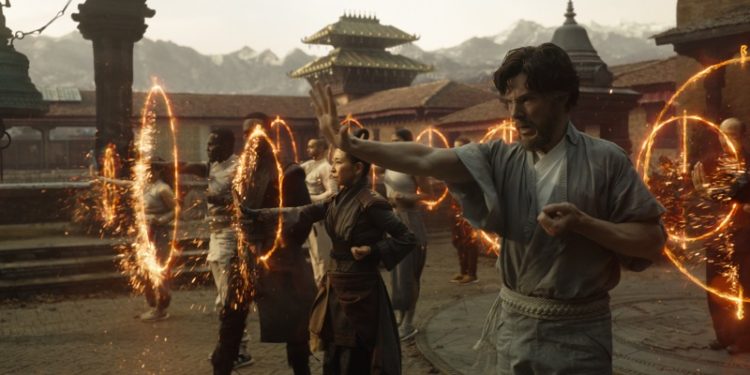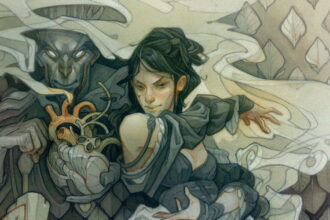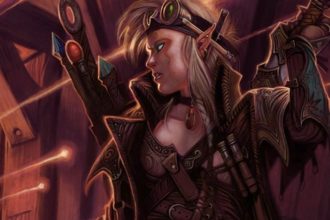The Monk Class, Part Five

We come now to the monk of Fourth Edition D&D, which as I have been hinting for a long time is a very unusual presentation of the class. In the source-role jargon of the edition, it is the only Psionic Striker class they released, but it has nothing in common with other Psionic-source classes – no psi pool, and their ki is not a class currency in any sense. And that’s just the beginning…
Part One | Part Two | Part Three | Part Four | Part Five
First off, my image choice for this article: I finally got around to seeing Doctor Strange, and the 4e monk does a way better than average job of representing the monk/wizard dichotomy of the movie’s characters. Since this is 4e, there’s a huge variety of powers, and if you really wanted to go all-in, just allow characters to play 4e monks but also pick up a smattering of wizard spells. As long as you’re creative in resolving the attribute dependency of each power, Doctor Strange turns out to be one of the best 4e-flavored movies ever filmed. (I loved the movie, and I loved 4e back when we played it, so I mean this as dual praise.)
The thing is, there’s nothing actually going on in the monk that defines it as psionic, other than the fact that it’s clearly not simply martial – the damage types and effects are too overtly supernatural for 4e’s approach to the martial source. Psionic Power goes in another direction with this, with some powers that barely fit the monk but are strongly psionic-themed. Let’s start with core features.
- 12 + Con score hit points at 1st level, and 5 hit points per level thereafter. On par with the rogue and the ranger.
- 7 + Con modifier healing surges, one better than the rogue and ranger (because they don’t expect you to have an even halfway decent score left over for Con).
- Cloth armor proficiency, which is going to wind up working about the same as the avenger’s cloth armor proficiency – Dex is one of their main ability scores, and they have an additional feature to get their AC up to where it should be.
- They can wield a very narrow selection of weapons, though there’s a sidebar that explains how barely relevant these are. Mostly they use ki focuses for everything, but they can treat any weapon they are proficient in as an implement.
- In brief, the sidebar says that monks use weapons to benefit from some of their feat options, and to make ranged basic attacks. Monks have an unarmed melee basic attack option that is equivalent to a longsword, stat-wise.
- Monk powers never use [W] (weapon damage, that is) in their damage expressions, so no matter what they’re using, it’s always a stat stick.
- The monastic tradition introduced in Psionic Power ditches this and emphasizes weapon use heavily, though it still doesn’t base damage on the weapon’s damage die.
- Monks gain a +1 to Fort, Ref, and Will defense, in keeping with “monks are good at all saves” from 3.x.
- Monks get four trained skills, which is midrange in 4e.
- Unarmored Defense grants a +2 bonus to AC when the monk wears cloth or no armor and does not use a shield.
- Unarmed Combatant is the feature that grants monks their longsword hands. Their unarmed attacks cannot be enchanted, but they do gain the benefits of a ki focus item if they have one.
- The two builds – Monastic Traditions – of the Player’s Handbook 3 are Centered Breath and Stone Fist, while Psionic Power tacks on the Iron Soul tradition.
- Centered Breath is for contemplative ascetics. Its special features are a scaling bonus equal to your tier to Fortitude defense, which… seems to run exactly counter to stated theme, but whatever; it also grants the Centered Flurry of Blows power, which is a free action triggered when you hit with an attack. It tacks on extra damage and allows a little forced movement. As you gain levels, you hit more people with it and move them around. Centered FoB rewards a high Wisdom as a secondary attribute.
- Stone Fist is for hardcore athletes and adrenaline junkies. So, obviously, it grants a scaling bonus to, um, Will defense. Sure. It also grants the Stone Fist Flurry of Blows power, which drops the forced movement of Centered FoB for a better damage kicker. Stone Fist FoB rewards high Strength as a secondary attribute.
- I’m giving Centered Breath and Stone Fist some flak here, but what’s actually happening is that your defenses stay balanced and high even when your ability scores won’t directly support that. It’s just not well supported in any narrative way.
- Iron Soul is for monks who do go in for weapons. It grants a +1 bonus to AC when you use a weapon that isn’t part of the unarmed group. The Iron Soul Flurry of Blows power has a minor damage kicker that rewards a high Con score, and splashes around some action denial – the target you hit with the triggering attack cannot shift, and at higher tiers, other adjacent enemies cannot make opportunity attacks until the end of your turn.
- In general, monk attack and utility powers don’t have differing effects based on your monastic tradition, though a modest number of powers work differently if you are Iron Soul and using a particular weapon type. The result is that Iron Soul monks play a little more like fighters, selecting powers based on an anticipated weapon loadout.
- As usual for 4e articles in the History of the Classes, I’m not covering each power in detail. There are a few notable trends, though:
- Monk at-will and encounter attack powers have the Full Discipline keyword. This is the central weirdness of the 4e monk: “Full Discipline” means that it offers both an attack technique and a movement technique. The majority of your attack powers, then, are also utility powers – and you can burn through all of your encounter powers much, much faster than other classes do. It also means that these powers have a lot more moving parts and fine details to recall; if you’re like me, this kind of complexity is exactly what made 4e melt down into near unplayability at paragon tier (to say nothing of epic tier, which I never played.)
- There are a ton of Three! Word! Attacks!, which you find throughout 4e, but it fits the ultra-wuxia monk wildly better than any other class in the edition. Many of these actually feel like in-character names, unlike anything outside of spellcasting classes. Also, Wind Walker is straight-up wire-fu as an at-will movement feature. (Gotta be 22nd level, though!)
- Many monk feature names of 3.x show up as powers here, like Abundant Step, Leap of the Heavens, and Quivering Palm. Also, features like Internal Power are just renames of Wholeness of Body. Amusingly, Stunning Fist is a 29th-level power, rather than the core of the class as in 3.x.
- While the 4e monastic traditions do not remotely presage the 5e monastic traditions, many of the powers and paragon paths do: Rising Dragon Fire and Three Winds Kick suggest the Elemental monk, there are all sorts of suggestions of the Open Hand monk, and the Radiant Soul clearly just becomes the Sun Soul. Looking back at it from a 5e perspective, it also suggests a beast-focused monastic tradition, and possibly more than one. Sure, it starts to sound very Kung Fu Panda and/or Karate Kid, but… cobras, hydras, cranes, and turtles all show up here, and it’s positively lousy with dragons. I wouldn’t mind seeing a Totemic or Serpent monastic tradition… who am I kidding, we all know I’m going to run out and write this as soon as I can.
The good side of this class is that it’s stylish, flashy in ways that suit its fiction, and as far as I can tell, pretty good at its job. The down side is that it is 4e at Peak Complexity. Many of the powers offer inspiration for 5e monk features – not 1:1, maybe, but interesting ideas. Overall, I like what I see here (despite its complexity), I wouldn’t mind seeing ki focus items show up in 5e in some form, and I sort of miss Cloth as a viable, scaling armor group beneath leather. (I’m well aware that bounded accuracy makes this a non-starter, don’t worry.)
What we don’t see in 4e is any clear suggestion that monks come from an Asian-inspired culture; at most, the philosophy is more in line with Asian teaching than Greek and Roman philosophy. Because they aren’t locked into some of the more mystical (and often ribbon-ish) high-end features like Timeless Body and Perfect Self, it’s much easier to treat these monks as semi-magical brawlers, dancers with strange and secret powers, or the like. The features they do receive may inspire an alternate collection of those high-end features, if the 5e monk doesn’t fit your setting very well.
Now I turn this to you, O my cherished readers: are there other presentations of the monk in tabletop gaming that you would like to see in the next article in this series? When I write the article for 5e, that’s (usually) the end of the series for a particular class, but since this is only the fifth article on the monk so far, I’m happy to push that back by a few weeks. (Safely assume that I don’t have a copy of whatever you’re suggesting.) Whatcha got?
Also, as usual, if you played a 4e monk, feel free to share your war stories about that character here.



